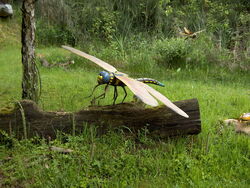| Meganeura Monyi | |
|---|---|
| Characteristics | |
| Era | Paleozoic |
| Period | Late Carboniferous |
| Living Period | 305 – 299 million years ago |
| Region | Europe |
| Size | Wingspan: 75 cm |
| First Appearance | Chapter 74 |
Description[]
Meganeura monyi was a species of flying insect that lived during the Carboniferous period, about 300 million years ago. It is believed to be related to modern dragonflies, and is the largest known flying insect species - it had a wingspan of about 75 cm.
Meganeura was a carnivore and is believed to have fed on other insects as well as small amphibians. There has been a lot of debate about why it was able to grew so large - one possibility is that a higher partial pressure of oxygen in the atmosphere made conditions more suitable to the evolution of large insects.
Shirou's History Fact[]
The largest insect in history, and a relative of the dragonfly that lived in the swampy land of the Carboniferous Period. It hunted other flying insects and small animals on the ground by flying and gliding down on them from above. Its larvae, which could be up to 30cm in length, were similar to its adult form in that they were also fierce predators. They ambushed prey from holes that they dug in the swamp floor. They hunted not only other insects, but also small amphibians and reptiles.
Chronology[]
Gigantopithecus arc[]
| Prominent Animals |
|---|
| Chimera • Chimera II • Ernest • Mr. Lucky |
| Extinct Animals |
|---|
| Ammonoidea • Ancient Ticks • Anomalochelys • Arctodus Simus • Argentavis • Alectroenas Nitidissima • Ambulocetus • Andrewsarchus Mongoliensis • Arsinoitherium • Basilosaurus • Bos Primigenius • Canis Dirus • Chalicotherium • Cheirolepis • Crassigyrinus • Cyclotosaurus • Diatryma • Entelodon • Eumegamys • Eusmilus • Eusthenopteron • Gerrothorax • Gigantopithecus • Glyptodon • Harpagornis Moorei • Holoptychius • Hyaenodon • Hypsognathus • Hyracotherium • Ichthyornis • Ictitherium • Ischyromys • Kannemeyeria • Lystrosaurus • Macrauchenia • Mammuthus Imperator • Megaladapis Edwardsi • Meganeura Monyi • Megatherium Americanum • Meiolania • Mesohippus • Moeritherium • Necrolemur • Nemegtbaatar Gobiensis • Notharctus • Paraceratherium • Pristichampus • Propleopus • Ptilodus • Rodhocetus • Smilodon • Titanis Walleri • Triadobatrachus • Unknown Extinct Animals |

